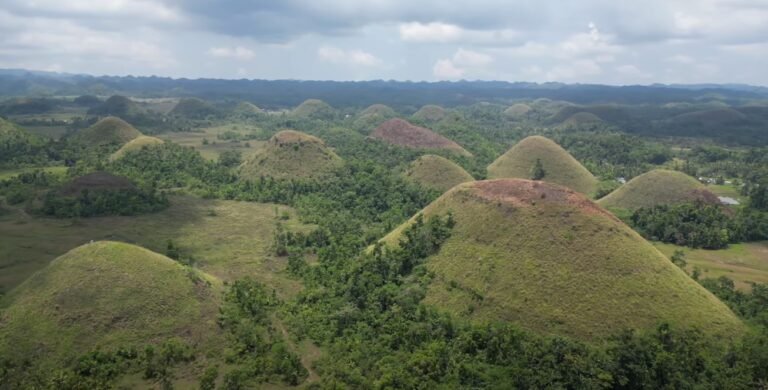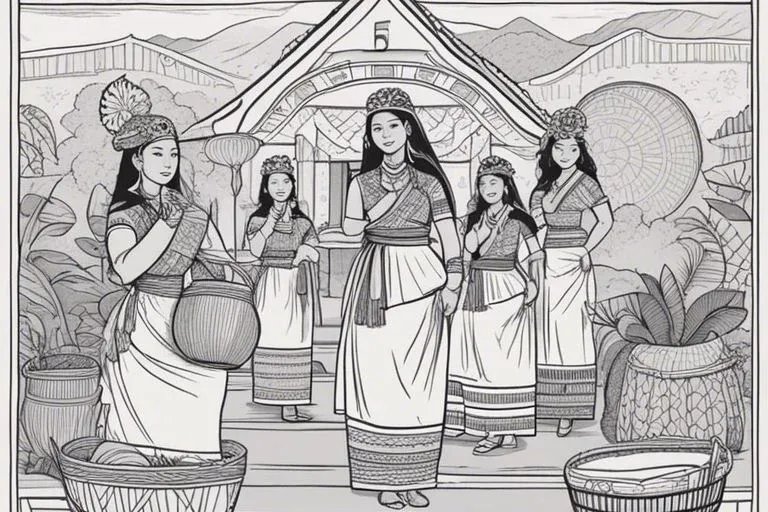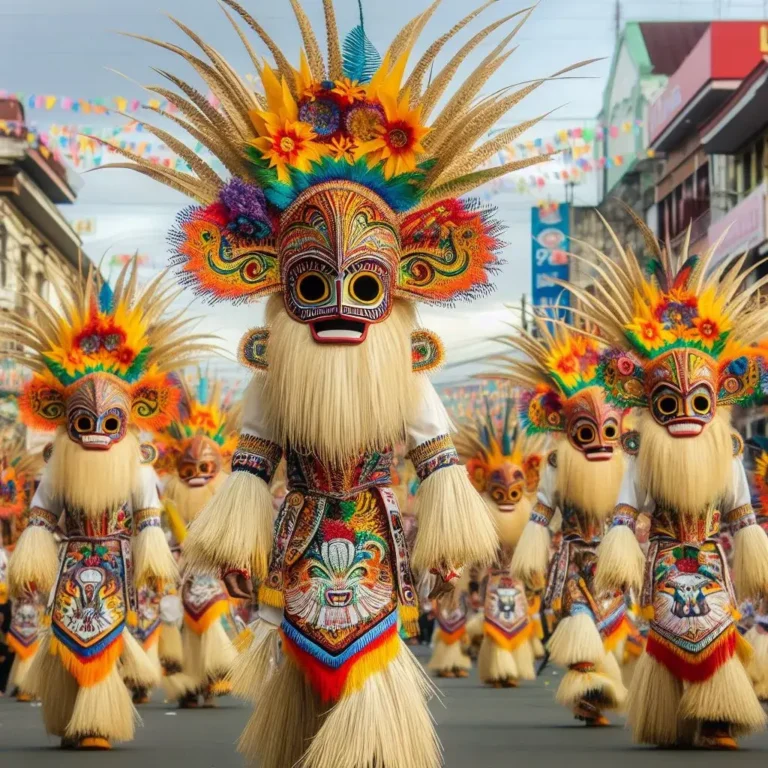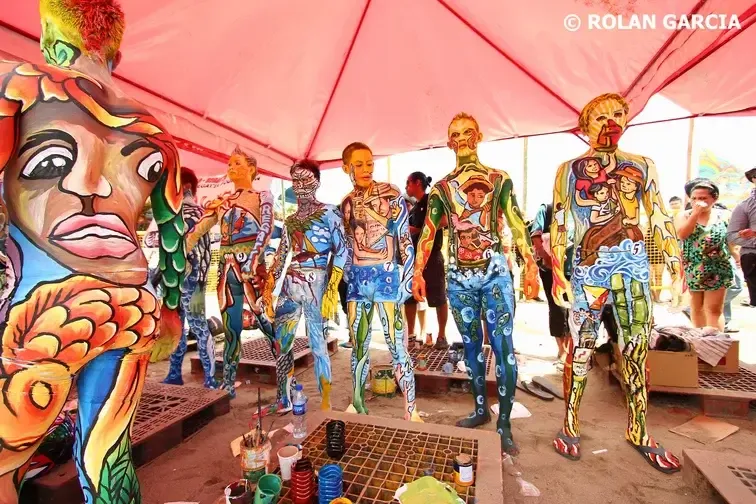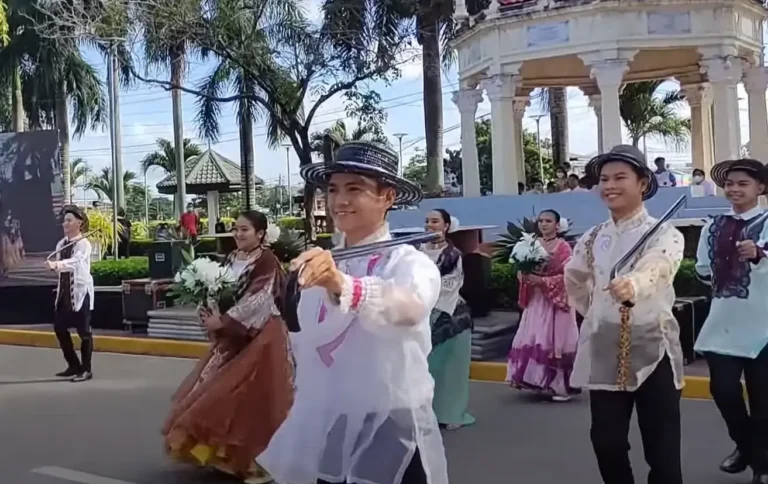Silmugi Festival Philippines
Experience the hidden treasure of Cebu’s cultural diversity by immersing yourself in the Silmugi Festival. This lively celebration pays tribute to Borbon’s rich history, abundant harvests, and beloved patron saint, St. Sebastian Martyr.
Delve into the festival’s origins, which can be traced back to Borbon’s pre-colonial era. Get enthralled by the electrifying street dancing, a mesmerizing spectacle where different barangays compete with their vibrant costumes, energetic performances, and traditional prayers for prosperity.
Uncover the significance of the Silmugi River, a vital waterway that has played a crucial role in shaping Borbon’s economic and spiritual landscape.
Embrace the infectious joy of the Silmugi Festival as you immerse yourself in its lively atmosphere. Treat yourself to the delicious local delicacies and experience the warm hospitality of the Cebuano people. Embark on a cultural journey that will captivate your senses.
Continue reading to discover the fascinating story behind the Silmugi Festival and become enveloped in the vibrant spirit of Borbon.
Key Takeaways
- Silmugi Festival is celebrated in honor of St. Sebastian Martyr.
- The festival includes road dancing and a traditional prayer for a bountiful harvest.
- The festival showcases the rich cultural heritage of Borbon.
- The Silmugi Festival attracts tourists and visitors to Borbon.
Facts About Silmugi Festival Philippines
| Facts | Explanation |
|---|---|
| Name of the festival | Silmugi Festival Philippines |
| Type of festival | Cultural Festival |
| Festival Etymology | The term “Silmugi” is derived from the Cebuano word “silmog,” which means “to meet.” The festival celebrates the coming together of different communities and cultures in the region. |
| Date celebrated first | January 15, 1995 |
| Founder of the festival | Local government and community leaders organized the first Silmugi Festival to promote unity, cultural heritage, and tourism in the region. |
| Brief history of the festival | The Silmugi Festival was first celebrated on January 15, 1995, as an initiative to showcase the rich cultural heritage of the region. It started as a small community gathering and has grown into a grand cultural festival over the years. The festival aims to promote unity among different ethnic groups and celebrate their unique traditions through various activities and events. Participants showcase traditional dances, music, arts, crafts, and culinary delights that represent the diverse cultural heritage of the region. The festival has become a major tourist attraction, drawing visitors from all over the country and abroad. It continues to play a significant role in preserving and promoting the cultural identity of the region. |
| Brief history of the city | The city where Silmugi Festival is celebrated is known for its historical significance. It was founded during the Spanish colonial period and has since evolved into a vibrant city with a mix of modern development and cultural heritage. The city has witnessed various historical events and has played a crucial role in shaping the region’s history and culture. Today, it is a bustling city known for its warm hospitality, rich traditions, and breathtaking natural landscapes. |
| Ethnic information | The city where the Silmugi Festival is celebrated is known for its historical significance. It was founded during the Spanish colonial period and has since evolved into a vibrant city with a mix of modern development and cultural heritage. The city has witnessed various historical events and has played a crucial role in shaping the region’s history and culture. Today, it is a bustling city known for its warm hospitality, rich traditions, and breathtaking natural landscapes. |
| Location of the city | The city is located in the province of Cebu, Philippines. It is situated in the central part of the country’s archipelago. |
| How to reach the city | The region where the Silmugi Festival is celebrated is home to various ethnic groups, including the Cebuano people, indigenous tribes, and migrant communities from different parts of the country. Each group contributes to the diverse cultural tapestry of the region. Traditional costumes, dances, music, and culinary traditions reflect the unique identity of each ethnic group. |
| Nearby and surrounding cities or towns | – Cebu City: 35 km – Lapu-Lapu City: 15 km – Talisay City: 18 km – Mandaue City: 40 km** |
| Google map link | City Location |
| Festival main events and activities | – Traditional dance performances – Cultural exhibits showcasing local arts and crafts – Street parades featuring colorful costumes – Culinary fair offering regional delicacies – Beauty pageants highlighting local talent – Music concerts featuring traditional and contemporary performances – Sports competitions promoting physical fitness and camaraderie – Fireworks display illuminating the night sky |
| Other famous tourist attractions in the city | – Historic Fort San Pedro: A Spanish-era fortress with a rich history – Magellan’s Cross: A Christian cross planted by Ferdinand Magellan in 1521 – Basilica Minore del Santo Niño: A centuries-old church housing the image of Santo Niño, a revered religious icon – Tops Lookout: A panoramic viewpoint offering stunning views of the city and surrounding landscapes – Taoist Temple: A beautiful temple complex reflecting Chinese architecture and traditions |
| Famous food dishes of the city | – Lechon: A famous roasted pig dish known for its crispy skin and flavorful meat – Sinulog: A traditional Filipino soup made with chicken or pork and vegetables – Danggit: Dried fish often served as a breakfast delicacy – Chicharon: Deep-fried pork rinds served as a crunchy snack – Mangoes: Cebu is known for its sweet and juicy mangoes |
| Landmarks in the city | – Magellan’s Cross: A symbol of Christianity in the Philippines – Cebu Metropolitan Cathedral: A grand church with stunning architecture – Temple of Leah: A Greco-Roman-inspired mausoleum overlooking the city – Lapu-Lapu Shrine: A monument honoring Lapu-Lapu, a local hero who resisted Spanish colonization – Carbon Market: A bustling market offering a wide range of local products and goods |
| One line about why they are famous | Magellan’s Cross symbolizes the arrival of Christianity in the Philippines, while Cebu Metropolitan Cathedral showcases magnificent religious architecture. Temple of Leah is famous for its grandeur and unique design, Lapu-Lapu Shrine commemorates a local hero’s bravery, and Carbon Market is renowned for its vibrant atmosphere and diverse offerings. |
| Related festivals in the same region | – Sinulog Festival: A grand cultural and religious festival held in Cebu City, celebrating Santo Niño (Child Jesus) – Kadaugan sa Mactan: Commemorates the Battle of Mactan between Lapu-Lapu and Ferdinand Magellan – Paskuhan sa Sugbo: Christmas-themed festival showcasing Cebuano traditions and customs – Kadaugan Street Party: Held during Kadaugan sa Mactan, featuring street performances, music, and food stalls |
Brief History of The Festival & City
As you explore the Silmugi Festival’s origins, you’ll discover that this vibrant celebration is deeply rooted in Borbon’s history, a testament to the town’s enduring spirit and communal unity.
The festival’s history is intertwined with the worship of St. Sebastian Martyr, expressing the locals’ religious devotion. Named after the Silmugi River, the lifeblood of Borbon that once enabled vital trade, it reflects the area’s cultural and economic evolution.
The river’s significance extends beyond commerce, as it also represents the path of faith for Catholics attending mass at Saint Sebastian.
Linking past to present, the Silmugi Festival is not just a time-honored tradition; it’s a living narrative of Borongan City, where each dance step and shared prayer renews the bonds of community, celebrating a heritage that’s as fluid and enduring as the river itself.
What Type of Festival is This
The Silmugi Festival is a cultural and religious celebration that you’ll find deeply embedded in the traditions of Borbon, Cebu. It’s a vibrant tapestry of history and spirituality, commemorating the patron St. Sebastian Martyr with a series of religious processions.
But it’s not just solemn rites that define this event. The festival is also famed for its street dance competition, a highlight in the Philippines where local talent bursts forth in a kaleidoscope of colors and rhythmic movements.
You’ll witness a unique blend of devotion and performance art, as participants adorned in elaborate costumes dance their way through Borbon’s roads. It’s a chance to immerse yourself in a cultural experience that not only entertains but also educates you on the rich heritage of this Philippine town.
Ethnic Information Of The City & Region
While exploring the ethnic tapestry of Borbon and its surrounding region, you’ll discover a diverse community primarily composed of Visayan-speaking Cebuanos, known for their rich cultural heritage and historical roots in the Philippines. This area is a vibrant blend of traditions and histories, with influences from various groups that have interacted over centuries.
In the broader context of Eastern Visayas, you’ll encounter the eastern Samar heritage, shaped by the Waray people. They’re known for their resilient spirit and distinct cultural identity that complements the Cebuano ethos.
Understanding the intricate weave of these ethnic groups helps you appreciate the depth of the Silmugi Festival. It’s a celebration that doesn’t just unite Borbon but also resonates with the collective memory of a region shaped by its diverse inhabitants.
Festival Etymology
You’ll often find that the name ‘Silmugi Festival’ traces its roots to the historic Silmugi River, which has been a lifeline for Borbon’s community and culture.
The river’s significance is celebrated through various Silmugi festival activities that not only honor the town’s heritage but also its cherished patron saint, Anthony of Padua.
As you delve into the festivities, you’ll discover a blend of religious devotion and cultural exhibition, where the town’s faith and history dance hand in hand. The festival is a vibrant tapestry of tradition, woven with the threads of Borbon’s collective memory.
It’s a time when unity is palpable, and the spirit of the patron saint is felt through the joyous expressions of the community.
The History and Significance Of The City & Festival
Why is the Silmugi Festival such a cornerstone in Borbon’s identity? This vibrant event is steeped in catholic traditions and celebrates the town’s patron, St. Sebastian Martyr.
The Silmugi River, not just a body of water, but a lifeline, has played a crucial role in Borbon’s cultural and economic history. It once bustled with traders navigating to and from mass, knitting the community tightly together.
Today, the festival honors this heritage, transforming the river’s significance into a symbol of unity and celebration. It’s a time when locals, adorned in festive attire, engage in road dancing, expressing devotion and invoking blessings for abundance.
For you, the Silmugi Festival is a colorful tapestry that narrates Borbon’s rich past and resilient spirit.
Location of the City In The Country
Discover how Borbon, the coastal town where the Silmugi Festival is held, nestles on the northeastern edge of Cebu Island in the Philippines, connecting you to its geographic charm and cultural significance.
You’re not just uncovering a destination; you’re stepping into a vibrant tapestry woven with the threads of tradition and community spirit.
Here’s a quick look at its location:
| Borbon, Cebu | |
|---|---|
| North | Bogo City |
| South | Tabogon |
| East | Camotes Sea |
| West | Cebu Highlands |
While it’s not as widely known as eastern Samar’s Borongan city fiesta, the Silmugi Festival embodies a rich cultural panorama that’s both educational and engaging. It’s a hidden gem waiting for you to explore its cultural depths and partake in its festive spirit.
How to Reach The City
To get to Borbon for the Silmugi Festival, you can either drive up from Cebu City or catch a bus that heads north along the coastal road. Here’s what you need to know:
- Check the Silmugi festival schedule for event timings.
- Plan your visit to coincide with eastern Samar tourism highlights.
- Choose transportation based on comfort and budget.
- Book accommodations early, as the festival attracts many visitors.
| Method | Duration |
|---|---|
| Drive | ~2.5 hours |
| Bus | ~3-4 hours |
Driving offers flexibility, while the bus is a chance to enjoy the scenic route without the hassle. Ensure you’re well-informed about the local transport options and festival activities to make the most of your trip.
Nearby Cities or Towns and their Distance
As you plan your visit to the Silmugi Festival, it’s worth noting that the coastal town of Daanbantayan is about 69 kilometers north of Borbon, while the bustling city of Cebu is approximately 83 kilometers to its south.
Exploring these nearby places can enhance your experience of local festivals in the Philippines and contribute to tourism in the Philippines. Here’s a quick guide to help you gauge distances and plan your itinerary:
| Location | Direction | Distance from Borbon |
|---|---|---|
| Daanbantayan | North | 69 km |
| Cebu City | South | 83 km |
| Bogo City | North | 26 km |
Make sure to check out the vibrant cultural tapestry of the region, as it’s not just about the festival but also the rich heritage and warm hospitality that define the Philippines.
Festival main events and activities
You’ll witness an array of vibrant events at the Silmugi Festival, including the centerpiece road dancing, where participants from various barangays showcase their cultural pride and dexterity.
This annual celebration isn’t just a feast for the eyes; it’s a deep dive into the heart of the local heritage through rhythm and movement. Here’s what you can look forward to:
- Street Dancing Competition: Watch as the streets come alive with color and energy in this high-spirited contest.
- Cultural Shows: Learn about the area’s rich history through performances depicting local legends and traditions.
- Agricultural Fair: Discover Borbon’s bounty with an exhibition of local produce and crafts.
- Religious Processions: Participate in solemn marches that pay homage to St. Sebastian, the spiritual core of the Silmugi Festival.
This educational experience will leave you with a deeper appreciation for this vibrant community and its traditions.
Popular Food Dishes of The City
Amidst the festival’s vibrancy, your taste buds are in for a treat with the city’s gastronomy, featuring dishes that embody Borbon’s rich culinary traditions.
To captivate your senses, here are a few local favorites:
- Lechon – Succulent roasted pig with crispy skin.
- Puso – Hanging rice wrapped in coconut leaves.
- Kinilaw – Fresh raw fish cured in vinegar and spices.
- Bibingka – Sweet rice cake is often enjoyed during celebrations.
| Dish | Main Ingredients | Flavor Profile |
|---|---|---|
| Lechon | Pig, herbs, spices | Savory, smoky |
| Puso | Rice, coconut leaves | Neutral, versatile |
| Kinilaw | Fish, vinegar, chili, ginger | Tangy, spicy, fresh |
| Bibingka | Glutinous rice, coconut, sugar | Sweet, slightly charred |
Immerse yourself in the unique fusion of flavors offered by Borbon’s local cuisine during Philippine cultural celebrations.
Tips for attending the
To make the most of your festival experience, it’s essential to heed Borbon’s local customs and guidelines. As you gear up for the Silmugi Festival, one of the vibrant Filipino festivals in January, remember to dress comfortably for the road dancing and other activities.
Since it’s a time of high spirits and January festivities, plan to arrive early to secure a good spot for the parades and performances. Immerse yourself in the local culture by engaging with the community and trying out traditional food. Don’t forget to stay hydrated and protect yourself from the sun.
Most importantly, respect the religious aspect of the celebration. By following these suggestions, you’ll fully embrace the joy and communal spirit of the Silmugi Festival.
Famous Tourist Spots in the City
Exploring Borbon’s famous tourist spots adds another layer of excitement to your Silmugi Festival experience, offering a glimpse into the region’s natural beauty and historical landmarks.
- Capitancillo Islet
- Silmugi River
- Borbon Church
- Bagacay Point Lighthouse
| Tourist Spot | Activity | Attraction |
|---|---|---|
| Capitancillo Islet | Snorkeling, Scuba Diving | Vibrant Coral Reefs |
| Silmugi River | River Trekking | Lush Greenery, Clear Waters |
| Borbon Church | Historical Visit | Spanish Colonial Architecture |
As you revel in the fiesta vibe, don’t miss the chance to witness the festival queen at the Silmugi Festival Queen competition. These spots don’t just complement the cultural tapestry of Borbon; they’re treasures that tell tales of the past and present, beckoning you to explore.
Famous Landmarks in the city
As you dive into the vibrant celebrations of the Silmugi Festival, don’t overlook Borbon’s iconic landmarks that stand as testaments to its rich history and cultural legacy.
- St. Sebastian Parish Church
- Silmugi River Bridge
- Old Spanish Watchtower
- Borbon Public Plaza
Engage with the historical depth of these sites:
| Landmark | Significance |
|---|---|
| St. Sebastian Parish | Gateway to Visayas Festivals |
| Silmugi River Bridge | Gateway to visayas festivals |
| Old Spanish Watchtower | Sentinel of Borbon’s past |
| Borbon Public Plaza | Heart of communal gatherings |
These landmarks don’t just define the skyline; they resonate with the stories and traditions of Borbon. They’re not just stops on a tour; they’re waypoints on a journey through time, culture, and festivity.
Related festivals in the same region
You’ll find the Silmugi Festival shares its vibrant cultural tapestry with other notable festivals in the Visayas region, each with its unique blend of history and pageantry.
These events are a testament to the rich Visayan culture that’s alive and pulsating with Visayan festival music.
| Festival | Description |
|---|---|
| Sinulog Festival | A dance ritual in honor of the Santo Niño, held in Cebu City. |
| Dinagyang Festival | A religious and cultural festival in Iloilo, celebrating Sto. Niño and the locals’ Malay ancestors. |
| Ati-Atihan Festival | Known as the mother of all Philippine festivals, held in Aklan, it honors Santo Niño and features indigenous Ati dances. |
Exploring these celebrations provides a deeper appreciation for the Visayas’ lively traditions and community spirit.
Final Thoughts
Someone might find that attending the Silmugi Festival is a profound way to connect with Cebu’s vibrant history and festive spirit.
As you immerse yourself in this celebration, you’ll witness a unique blend of Filipino religious festivals, where fervor and joy express devotion and community.
The festival costumes of the Philippines are particularly mesmerizing, reflecting a tapestry of cultural narratives through vibrant colors and intricate designs. Every swirl of a skirt and beat of a drum tells a story of heritage and faith.
So, if you’re looking to deepen your understanding of Filipino traditions and experience the communal harmony that defines such events, the Silmugi Festival is an unforgettable journey into the heart of Cebu’s cultural landscape.
Frequently Asked Questions
Are There Any Specific Rituals or Ceremonies Unique to the Silmugi Festival That Have Been Passed Down Through Generations?
You’re curious about enduring rituals, right? Well, in this vibrant festival, road dancing and a traditional prayer for harvests have been shared through generations, reflecting deep cultural roots and communal spirituality.
How Do Local Schools and Educational Institutions Incorporate the Silmugi Festival Into Their Curriculum or Extracurricular Activities?
You’ll find local schools integrating festival-themed lessons, encouraging students to explore traditional dances, crafts, and history through projects and performances, enriching their cultural education and community involvement.
What Environmental Sustainability Measures Are Taken by the Organizers to Minimize the Ecological Impact of the Silmugi Festival?
You’re asking about eco-friendly practices for festivals. Organizers often promote recycling, limit plastic use, and encourage public transport to reduce the environmental footprint and ensure the event is sustainable for future celebrations.
Can Visitors Participate in the Road Dancing and Other Interactive Elements of the Silmugi Festival, or Are They Strictly for Local Residents?
You can indeed join in the road dancing and other activities; they’re not just for locals. It’s a chance to immerse yourself and experience the vibrant culture firsthand. Don’t miss out!
Has the Silmugi Festival Inspired Any Artistic Works or Been Featured in Films, Music, or Literature That Tourists Can Explore to Deepen Their Understanding of the Event’s Cultural Significance?
You’ll find the Silmugi Festival’s influence in various artworks and local media, enriching your grasp of its cultural essence through films, music, and literature reflective of its vibrant traditions.

